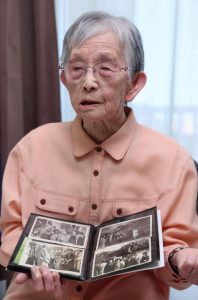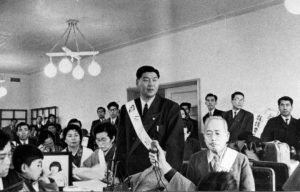Special feature series — Nihon Hidankyo awarded Nobel Peace Prize, Part 2: Pioneers brought awareness of nuclear weapons as “ultimate evil”
Oct. 13, 2024
Acted with voices of the voiceless carried on their backs
by Hiromi Morita, Staff Writer
“I’m thrilled at the news. I feel that what we’ve been doing for so long has finally received recognition.” Shizuko Abe, 97, an atomic bomb survivor who lives in Hiroshima’s Minami Ward, described how she had shed tears when she heard the news that Nihon Hidankyo (Japan Confederation of A- and H-Bomb Sufferers Organizations) had been awarded the Nobel Peace Prize.
“I’m sure Mr. Fujii and Mr. Kikkawa are also pleased at the news.” Ms. Abe named one after another of the pioneers of the movement who led the atomic bomb survivors at a time when they were suffering from the aftereffects of the atomic bombings as well as dire poverty without any aid or support.
Heiichi Fujii (1915–1996), the first secretary-general of Nihon Hidankyo who had lost members of his family in the atomic bombing, devoted his own money in the effort to obtain aid and support for A-bomb survivors. Kiyoshi Kikkawa (1911–1986), who became known as “Atomic Bomb Victim No. 1,” organized a survivors’ group in the early days and used to call out the reality of the atomic bombings by revealing his own scars.
Not only did such individuals pave the way for aid and support to be provided the survivors, but they also brought attention to the idea that nuclear weapons were the “ultimate evil” for people around the world. They shared the same kinds of scars and provided support to Ms. Abe, whose suffered burns to her face and body in the atomic bombing at a location around 1.5 kilometers from the hypocenter.
“This was our start.” Ms. Abe pulled out black-and-white snapshots and souvenir photographs taken 68 years ago when, in March 1956, around 50 survivors of the atomic bombings of Hiroshima and Nagasaki traveled to Tokyo to convey the desperate voices of A-bomb survivors to government Cabinet ministers and Japan’s parliamentary Diet. She joined the delegation led by Mr. Fujii, taking her child with her. The group raised the issue of their plight and demanded aid and support. Said Ms. Abe, “We did not receive a favorable response and were devastated as a result. That was when we decided we had to form a strong organization in our effort to call for help.”
In May of that year, survivors’ groups that had been working separately were banded together by Mr. Fujii and others, resulting in the formation of the Hiroshima Prefectural Confederation of A-bomb Sufferers Organizations. In August, the Nihon Hidankyo organization was launched at the Second World Conference Against Atomic and Hydrogen Bombs, which was held in Nagasaki.
The work of the organization helped heal Ms. Abe and nurtured her sense of mission. “It was painful for me to get strange looks from people, so I lived my life looking down at the ground. But my spirit was lifted when I went out and attended Nihon Hidankyo meetings. My family was also happy,” she said. The sentiment that “no others should be made to endure the same kind of suffering” eventually led to her decision to communicate her own experience in the atomic bombing to the public in Japan and overseas.
As its reason for awarding the Nobel Peace Prize to Nihon Hidankyo, the Norwegian Nobel Committee stated that it hoped to honor all A-bomb survivors.
Ichiro Moritaki (1901–1994), the first co-chair of Nihon Hidankyo and leader of the movement to ban atomic and hydrogen bombs, used to stage sit-in protests in front of the Cenotaph for the A-bomb Victims in Peace Memorial Park, in Hiroshima’s Naka Ward, each time a nuclear test was conducted. His second daughter, Haruko, 85, a resident of the city’s Saeki Ward, had heard from her father while he was still alive that the protestors “used to sit with their backs to the cenotaph because they were carrying the voices and regrets of the voiceless victims who died without being able to say anything.”
A pillar of the survivors’ movement is the complete rejection of war, which has the potential to lead to A-bomb devastation. Members of the movement have worked to demand compensation from the national government, based on their refusal to accept damage from war that a nation inflicts on its own people.
“We who are alive now need to pull ourselves together,” Haruko said when she heard the news of the award decision. “We must recall the origins of the A-bomb survivors’ movement.”
(Originally published on October 13, 2024)









